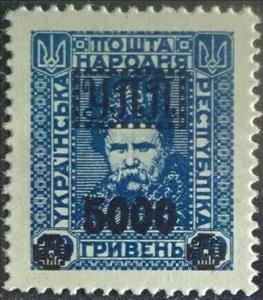Stamp: Taras Shevchenko (1814-1861) (Cinderellas 1923)
Taras Shevchenko (1814-1861) (Cinderellas 1923)
01 January (Cinderellas ) within release Ukraine goes into circulation Stamp Taras Shevchenko (1814-1861) face value 5,000 Ukrainian hryvnia
| Stamp Taras Shevchenko (1814-1861) in catalogues | |
|---|---|
| Colnect codes: | Col: UA 1923-01/06 |
Stamp is square format.
20 hryvnia unissued Ukraine stamp of 1920 overprinted "У.П.П." in a box and surcharged in black Prepared by the Ukrainian government-in-exile in Poland as a field post stamp, but never issued. Mentioned but not listed in Sn.Also in the issue Ukraine:
- Stamp - Bogdan Khmelnytsky (1595-1657) face value 1,000;
- Stamp - Bogdan Khmelnytsky (1595-1657) face value 1,500;
- Stamp - Bogdan Khmelnytsky (1595-1657) face value 2,000;
- Stamp - Symon Petliura (1879-1926) face value 8,000;
- Stamp - Symon Petliura (1879-1926) face value 10,000;
- Stamp - Symon Petliura (1879-1926) face value 15,000;
- Stamp - Symon Petliura (1879-1926) face value 20,000;
- Stamp - Symon Petliura (1879-1926) face value 25,000;
- Stamp - Taras Shevchenko (1814-1861) face value 2,500;
- Stamp - Taras Shevchenko (1814-1861) face value 4,000;
- Stamp - Taras Shevchenko (1814-1861) face value 5,000;
Stamp Taras Shevchenko (1814-1861) it reflects the thematic directions:
In legal discourse, an author is the creator of an original work, whether that work is in written, graphic, or recorded medium. The creation of such a work is an act of authorship. Thus, a sculptor, painter, or composer, is an author of their respective sculptures, paintings, or compositions, even though in common parlance, an author is often thought of as the writer of a book, article, play, or other written work.In the case of a work for hire, the employer or commissioning party is considered the author of the work, even if they did not write or otherwise create the work, but merely instructed another individual to do so.
A coat of arms is an heraldic visual design on an escutcheon (i.e. shield), surcoat, or tabard. The coat of arms on an escutcheon forms the central element of the full heraldic achievement which in its whole consists of shield, supporters, crest, and motto. A coat of arms is traditionally unique to an individual person, family (except in the United Kingdom), state, organisation or corporation.
Famous People refers to the fame and public attention accorded by the mass media to individuals or groups or, occasionally, animals, but is usually applied to the persons or groups of people (celebrity couples, families, etc.) themselves who receive such a status of fame and attention. Celebrity status is often associated with wealth (commonly referred to as fame and fortune), while fame often provides opportunities to make money.
Headgear may be worn for protection against cold (such as the Canadian tuque), heat, rain and other precipitation, glare, sunburn, sunstroke, dust, contaminants, etc. Helmets are worn for protection in battle or against impact, for instance when riding bicycles or motor vehicles. There are also hats that are worn for protection from the cold
A man is an adult male human. Prior to adulthood, a male human is referred to as a boy (a male child or adolescent).
A symbol is a mark, sign, or word that indicates, signifies, or is understood as representing an idea, object, or relationship. Symbols allow people to go beyond what is known or seen by creating linkages between otherwise very different concepts and experiences. All communication (and data processing) is achieved through the use of symbols. Symbols take the form of words, sounds, gestures, ideas, or visual images and are used to convey other ideas and beliefs. For example, a red octagon is a common symbol for "STOP"; on maps, blue lines often represent rivers; and a red rose often symbolizes love and compassion. Numerals are symbols for numbers; letters of an alphabet may be symbols for certain phonemes; and personal names are symbols representing individuals.






